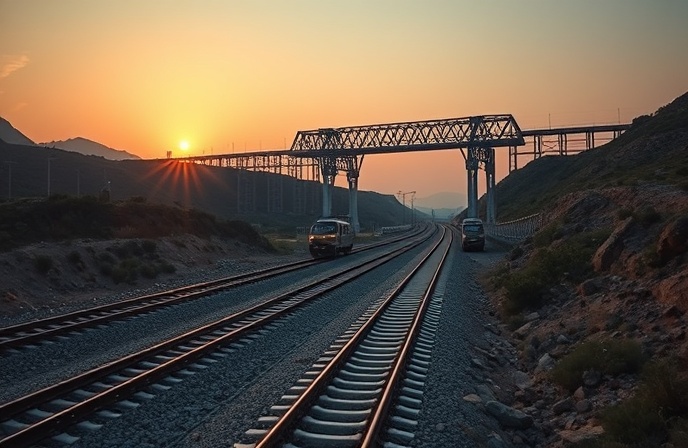OHL’s Spain High-Speed Rail: Mondragón-Bergara Insights
Spain’s €134 million high-velocity railway project showcases innovative NATM tunneling techniques and collaborative partnerships, delivering crucial infrastructure upgrades. Learn the secrets of its success!

OHL’s €134 Million High-Velocity Railway Project in Spain: A Case Study in Modern Rail Construction
This article delves into the significant €134 million contract awarded to a joint venture (JV) led by OHL (Obrascón Huarte Lain, S.A.) for the construction of a crucial section of the Vitoria-Bilbao-San Sebastián high-velocity railway (HVR) in Spain. The project highlights several key aspects of modern railway infrastructure development, including the application of advanced tunneling techniques, the complex logistical challenges of integrating new lines into existing networks, and the collaborative nature of large-scale infrastructure projects. We will examine the technical specifications of the Mondragón-Elorrio-Bergara section, the chosen construction methodologies, and the broader implications of this project for the Spanish railway network and the Basque region. This analysis provides valuable insights into the intricacies of large-scale railway construction and the role of public-private partnerships in delivering vital national infrastructure. The strategic importance of this section, its connection to the larger Basque network, and the economic impact on the region will also be discussed.
Project Overview: The Mondragón-Elorrio-Bergara Section
The €134 million contract awarded to the OHL JV encompasses the construction of the Mondragón-Elorrio-Bergara section of the Vitoria-Bilbao-San Sebastián HVR. This section constitutes Sector 1 and is crucial for completing the “Nudo de Bergara” (Bergara Knot), a vital interchange designed to significantly improve high-speed rail connectivity between the three Basque capitals: Vitoria-Gasteiz, Bilbao, and San Sebastián. The project’s scale is substantial, with a significant portion dedicated to tunneling.
Tunneling and Specialized Construction Methods
A defining feature of this project is the extensive use of tunneling. The JV will employ the New Austrian Tunneling Method (NATM), a flexible and adaptable approach particularly suited to complex geological conditions. This method emphasizes close monitoring of ground conditions and the use of support systems tailored to the specific challenges encountered during excavation. The project involves constructing three tunnels totaling 6,313 meters in length, representing over 89% of the total section. In addition to the main tunnels, the project includes the construction of a 200-meter artificial tunnel in Angiozar, an Aranostei viaduct spanning 20 meters, eight connecting galleries, retaining walls, and a 527-meter open-air platform. This intricate network of tunnels and supporting structures underscores the engineering complexity inherent in this undertaking.
Collaboration and Project Management
The project’s success hinges on effective collaboration amongst the JV partners. OHL holds a 40% stake, while Sobrino, G&O, and Geotunel hold 20%, 10%, and 30% respectively. This collaborative model leverages the specialized expertise of each partner, fostering efficient project management and risk mitigation. The experience of OHL, a company with nearly 200 completed projects in Spain, including recent HVR sections in Guipúzcoa, further strengthens the project’s prospects for timely and successful completion. The project also exemplifies the increasing trend towards public-private partnerships (PPPs) in large-scale infrastructure development.
Broader Implications for the Basque Railway Network
The completion of the Mondragón-Elorrio-Bergara section will be transformative for the Basque Country’s railway network. The improved connectivity facilitated by the Bergara Knot will significantly reduce travel times between the three major Basque cities, boosting economic activity and regional integration. This project contributes to Spain’s broader high-speed rail modernization strategy, aiming to enhance efficiency and accessibility across the country. The economic benefits extend beyond improved transportation; the construction itself generates jobs and stimulates local economies.
Conclusion
The OHL JV’s €134 million contract to build the Mondragón-Elorrio-Bergara section of the Vitoria-Bilbao-San Sebastián HVR represents a significant milestone in Spanish railway infrastructure development. The project showcases advanced tunneling techniques like NATM, highlighting the importance of adapting construction methods to specific geological conditions. The collaborative nature of the JV, involving OHL and its affiliates, demonstrates the efficiency and risk-mitigation benefits of public-private partnerships in managing large-scale infrastructure projects. The successful completion of this section will not only significantly improve high-speed rail connectivity within the Basque Country but will also contribute to broader economic growth and regional integration. The project serves as a compelling case study for future high-velocity rail projects, emphasizing the importance of meticulous planning, advanced engineering techniques, and effective collaboration in delivering vital transportation infrastructure.
The strategic importance of this project within the larger context of the Spanish HVR network and its positive impact on the Basque economy cannot be overstated. The use of NATM and the careful integration of tunnels, viaducts, and open-air sections demonstrate a sophisticated approach to railway construction. The success of this project will set a precedent for future high-speed rail expansion in Spain and other regions facing similar geographic and logistical challenges. Furthermore, the involvement of multiple specialized companies within the JV underlines the crucial role of collaborative partnerships in delivering complex and technically demanding infrastructure projects within budget and on schedule. The economic stimulation associated with the construction itself, in addition to the long-term economic benefits of enhanced connectivity, makes this investment a valuable contribution to the development of the Basque region and Spain as a whole.



